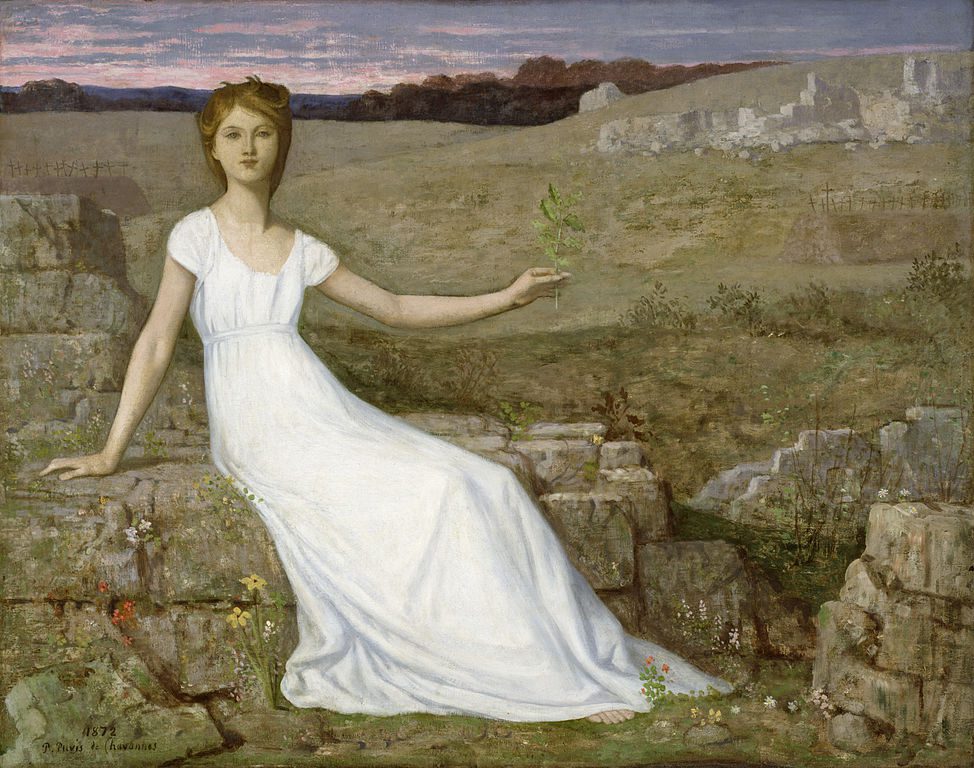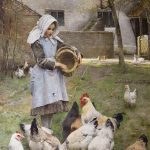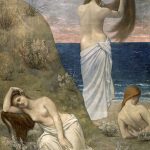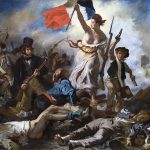
Anaïs Faure, a name quietly etched into the annals of 19th-century art, was the enigmatic model who helped shape the vision of Pierre Puvis de Chavannes, one of France’s most influential painters. While her life remains shrouded in mystery, Faure’s presence is indelibly marked in Chavannes’ ethereal murals and paintings. She was more than just a subject of his work—she was an embodiment of the ideals and aspirations of a time when art sought to transcend reality and express the timeless beauty of the human spirit.
Through her collaboration with Chavannes, Faure contributed to a body of work that became foundational to modern art and the Symbolist movement. Her role sheds light on the often-overlooked contributions of artists’ models, who shaped not just the individual works they appeared in but also the broader cultural ideals of beauty, virtue, and inspiration. Anaïs Faure’s story invites us to explore the artistic, cultural, and human dynamics that unfolded during one of the most transformative eras in European art.
Historical Context: 19th-Century France and the Role of Models
The 19th century was a time of rapid change in France, with society navigating the upheavals of industrialization, political revolutions, and cultural shifts. The art world, too, was undergoing transformation, as traditional forms gave way to new styles and movements. Artists like Puvis de Chavannes sought to respond to these changes by creating works that reflected both a sense of nostalgia for the past and a yearning for universality and idealism. This was the age of Realism, Impressionism, and later, Symbolism, each of which offered different ways of interpreting the human experience.
In this dynamic artistic landscape, models began to play a more significant role. No longer anonymous figures relegated to the background, they became central to the creative process, often inspiring not only the composition but also the themes of the works they appeared in. Models like Anaïs Faure bridged the gap between concept and execution, lending their physical presence and emotional resonance to the visions of the artists they worked with. They became living embodiments of the ideals artists sought to convey, whether rooted in realism or the more abstract aspirations of Symbolism.
Gender roles during this period also played a crucial part in shaping the role of models. Women, in particular, were often idealized in art, depicted as symbols of purity, virtue, or beauty. These portrayals, however, were a double-edged sword, reflecting societal expectations that confined women to specific roles while simultaneously celebrating their importance. Models like Anaïs Faure were often caught in this paradox, their contributions critical to the artistic process but their lives largely overshadowed by the men who painted them.
Who Was Anaïs Faure?
Anaïs Faure’s life remains an enigma, as historical records about her are sparse. What little is known about her comes through her association with Pierre Puvis de Chavannes and the artworks in which her likeness appears. Like many models of the time, Faure likely lived a modest and private life, far removed from the fame and recognition garnered by the artists she worked with. Models were often women from working-class backgrounds, drawn into the art world either by necessity or through personal connections to artists.
What made Faure particularly captivating to Chavannes remains open to speculation. Perhaps it was her physical grace, the serenity of her expression, or her ability to embody the timeless qualities Chavannes sought in his work. Chavannes’ paintings often depicted idealized figures, removed from the specificity of time or place, and Faure’s presence must have resonated deeply with this vision. Her features, at once distinct and universal, became a vessel through which Chavannes conveyed his philosophical and artistic ideals.
Despite the lack of biographical detail, Faure’s legacy endures in the paintings she inspired. Her image, preserved in works that continue to captivate audiences, offers glimpses into the life of a woman whose quiet contribution helped shape the trajectory of French art. Though her name may not appear in textbooks alongside Chavannes, her influence is woven into the fabric of his artistic output, reminding us of the essential yet often overlooked role of models in art history.
Relationship with Pierre Puvis de Chavannes
The relationship between Anaïs Faure and Pierre Puvis de Chavannes was likely one of deep artistic collaboration. While there is no evidence to suggest a romantic connection, the intensity of their working relationship is evident in the works she inspired. Chavannes, known for his meticulous approach to painting, often sought models who could bring his vision to life, and Faure was among those who rose to the challenge. Her poise and presence seemed to align perfectly with the ethereal quality of his art.
Chavannes was a pioneer of the Symbolist movement, which sought to depict universal truths and emotions through allegory and metaphor. His works often featured figures that represented ideals such as peace, wisdom, or purity. Faure’s presence in his paintings became a kind of visual shorthand for these concepts, her image radiating a sense of calm and timelessness that complemented Chavannes’ artistic goals. Through her, Chavannes was able to convey his vision of humanity’s higher aspirations, rooted in beauty and harmony.
One of the most striking aspects of their collaboration is the way Chavannes elevated the role of the model in his creative process. Unlike many artists of his time, who treated models as interchangeable figures, Chavannes seems to have recognized Faure’s individuality and incorporated it into his work. This approach not only enhanced the emotional depth of his paintings but also highlighted the unique qualities Faure brought to the table. Their partnership was a testament to the power of mutual respect and artistic synergy.
Iconic Works Featuring Anaïs Faure
Anaïs Faure’s likeness can be seen in several of Pierre Puvis de Chavannes’ most celebrated works. Among these is “The Sacred Grove, Beloved of the Arts and the Muses,” a monumental painting that embodies the harmony and timeless beauty that defined Chavannes’ style. In this piece, Faure is believed to have modeled for one of the serene figures, her calm demeanor and graceful posture perfectly aligning with the allegorical theme.
Another notable work is “Hope,” a painting that captures the universal longing for renewal and optimism in the face of despair. Faure’s features are evident in the central figure, whose introspective gaze and delicate form convey both vulnerability and strength. This work, like many of Chavannes’ paintings, blends realism with idealism, and Faure’s presence was instrumental in achieving this balance. Her ability to embody abstract concepts like hope and serenity set her apart from other models of the time.
Chavannes’ murals, which adorn public spaces such as the Panthéon in Paris, also bear traces of Faure’s influence. While these large-scale works often feature a multitude of figures, the central characters frequently echo Faure’s distinctive features. Her image, repeated across Chavannes’ oeuvre, became a symbol of the ideals he sought to convey, linking her forever to his artistic legacy.
Anaïs Faure as a Symbol of 19th-Century Feminine Ideals
In the 19th century, women were often depicted as embodiments of societal ideals, and Anaïs Faure was no exception. Through her collaboration with Chavannes, she became a symbol of the era’s vision of femininity—graceful, pure, and timeless. Chavannes’ works often portrayed women not as individuals but as allegories, representing concepts like peace, wisdom, or renewal. Faure’s image, with its serene expression and elegant poise, was perfectly suited to this purpose.
At the same time, the idealization of women in art reflected the constraints placed on them in society. While Faure’s image radiated strength and beauty, it also reinforced the narrow roles available to women during this period. They were celebrated as muses and icons but often denied agency and recognition in their own right. Faure’s story illustrates this paradox, as her contributions were vital to Chavannes’ work yet remain largely unacknowledged in historical records.
Legacy and Influence
Anaïs Faure’s contributions to the art world have been largely overlooked in historical documentation, a fate shared by many artists’ models of her era. However, her enduring legacy is embedded in the works of Pierre Puvis de Chavannes, whose paintings continue to be celebrated as masterpieces of 19th-century art. Through her presence in these artworks, Faure became a silent yet pivotal force in shaping the trajectory of Symbolism and its influence on later movements, including Art Nouveau and even modern abstraction.
Faure’s image became synonymous with Chavannes’ vision of an idealized, harmonious world. Her serene expression and timeless beauty inspired countless viewers, making her a vital part of his creative success. The murals and canvases she appeared in were not only admired by contemporary audiences but also influenced the next generation of artists, including Paul Gauguin, Odilon Redon, and the Nabis group. These artists absorbed Chavannes’ use of flattened forms, muted colors, and allegorical themes, many of which were brought to life through Faure’s modeling.
Beyond her influence on art, Faure also contributed to the evolving role of models in the 19th century. She was part of a subtle shift in how society viewed models, from nameless participants to integral collaborators in the creative process. While her name may not have been widely recognized in her time, her face and figure became iconic, preserving her contribution in a way that continues to resonate. Today, Faure’s story reminds us of the countless unsung individuals who have shaped cultural history from behind the scenes.
Broader Impact of Artist-Model Relationships
The relationship between Anaïs Faure and Pierre Puvis de Chavannes serves as a fascinating case study of the dynamics between artists and their models during the 19th century. While models were essential to the creative process, their contributions were rarely acknowledged beyond the confines of the artist’s studio. Faure’s collaboration with Chavannes highlights how models could act as both inspirations and active participants in the creation of art, bringing not just their physical presence but also their personalities and emotional depth to the work.
This dynamic can be seen across the art world during this period, as models like Camille Claudel, who worked with Auguste Rodin, or Fernande Olivier, who modeled for Picasso, began to gain recognition for their integral roles in shaping art history. Models were more than passive subjects—they were muses, confidantes, and in some cases, collaborators who profoundly influenced the artistic process. Anaïs Faure was part of this broader trend, her image shaping the visual language of Chavannes’ Symbolist masterpieces.
Artist-model relationships also reflect broader cultural and social dynamics, particularly around gender and class. Models, often women from modest backgrounds, occupied a unique space in the art world—admired and idealized on the canvas, yet often marginalized in real life. Faure’s experience illustrates these contradictions, as her image became immortalized in works that celebrated beauty and virtue while her personal story faded into obscurity. This paradox remains a key point of discussion in understanding the complexities of artist-model dynamics and the ways in which society has historically valued women’s contributions to culture.
Conclusion
Anaïs Faure’s role as a model for Pierre Puvis de Chavannes was far more significant than mere physical representation. Through her collaboration with one of 19th-century France’s most influential artists, she became an enduring symbol of the era’s artistic and cultural ideals. Faure’s serene presence in Chavannes’ works conveyed a timeless grace that resonated with contemporary audiences and continues to inspire art lovers today.
While her life remains largely undocumented, her contributions to the art world are undeniable. Faure’s image, immortalized in Chavannes’ allegorical paintings and murals, became a cornerstone of the Symbolist movement and a source of inspiration for generations of artists. She reminds us of the indispensable yet often overlooked role of models in art, whose presence gives life and depth to the visions of the artists they work with.
Anaïs Faure’s legacy invites us to look beyond the canvas and consider the lives of the individuals who helped shape the masterpieces we admire. Her story is a testament to the power of collaboration in art and the enduring impact of those who, though silent, leave an indelible mark on cultural history.
Key Takeaways
- Anaïs Faure’s contributions were vital to Pierre Puvis de Chavannes’ artistic success, making her a cornerstone of his Symbolist masterpieces.
- Her image embodies the cultural ideals of 19th-century femininity, blending grace, beauty, and timelessness.
- Faure’s likeness inspired not only Chavannes’ works but also later movements like Art Nouveau and modern abstraction.
- Artist-model relationships in the 19th century highlighted the paradox of models’ roles: central to the creative process but marginalized in recognition.
- Her legacy serves as a reminder of the often-overlooked contributions of models in art history, encouraging a deeper appreciation of their influence.
FAQs
- Who was Anaïs Faure?
Anaïs Faure was a model for Pierre Puvis de Chavannes, one of France’s leading Symbolist painters. She inspired many of his most iconic works and became a symbol of 19th-century artistic ideals. - What is Pierre Puvis de Chavannes known for?
Puvis de Chavannes is renowned for his allegorical murals and paintings, characterized by their serene, symbolic figures and universal themes. - Which artworks feature Anaïs Faure?
Anaïs Faure is believed to have modeled for several of Chavannes’ works, including “The Sacred Grove, Beloved of the Arts and the Muses” and “Hope.” Her likeness is also seen in his murals, such as those in the Panthéon in Paris. - What was the role of models in 19th-century art?
Models were essential to the creative process, often embodying the ideals and themes that artists sought to express. While their contributions were vital, they rarely received the recognition they deserved. - What is Anaïs Faure’s legacy?
Faure’s legacy lies in her enduring presence in Chavannes’ works, which continue to inspire audiences and remind us of the significant yet often unacknowledged role of artists’ models.




